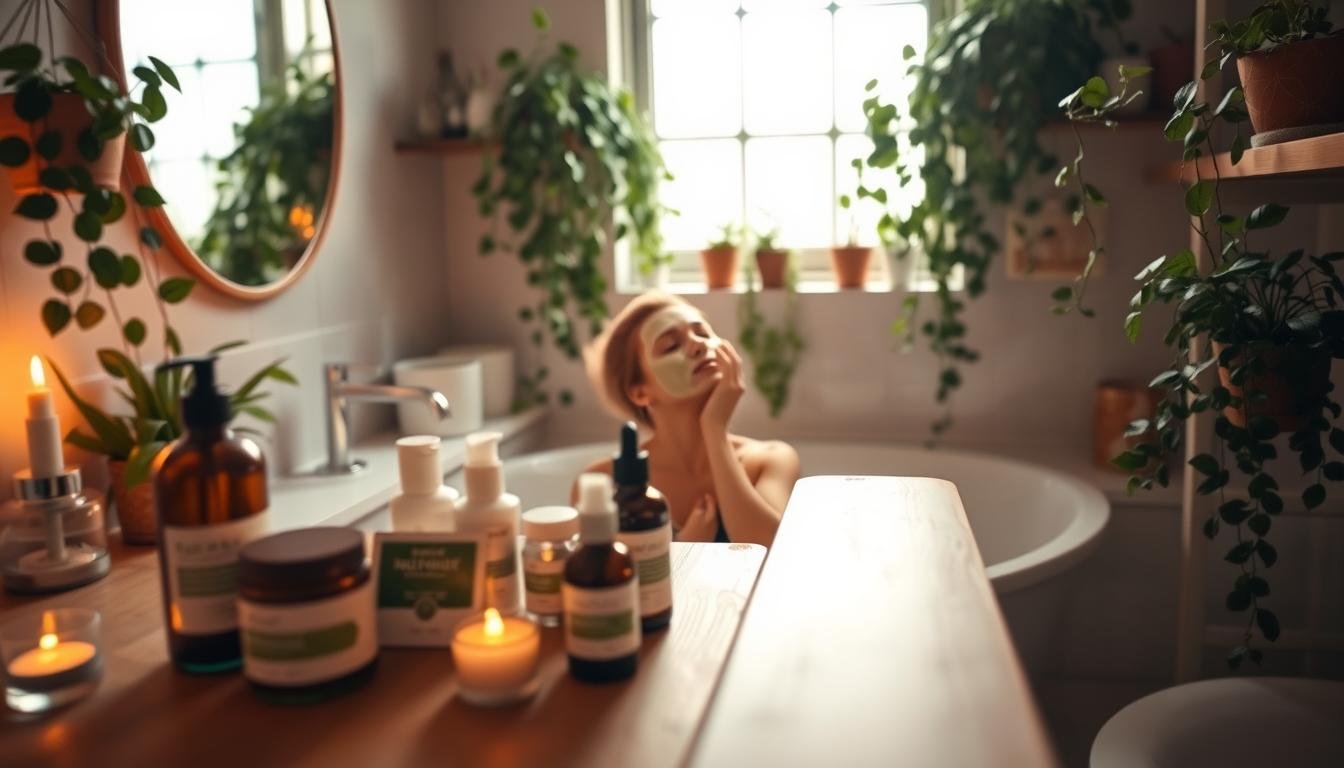“What you do makes a difference, and you have to decide what kind of difference you want to make.” – Jane Goodall’s words remind us that every choice matters. When it comes to personal care, your daily routine holds power far beyond the mirror. The average American spends over $1,700 yearly on cosmetics and skincare, creating a staggering environmental ripple effect.
But here’s the good news: small shifts in your habits can create lasting change. Switching to conscious brands that use renewable ingredients and recyclable packaging reduces waste without sacrificing results. Many of these products actually nourish skin better than conventional alternatives, cutting through the noise of harsh chemicals.
You don’t need to overhaul everything overnight. Start by rethinking one product at a time – maybe your shampoo bar or bamboo toothbrush. These choices add up, creating a self-care ritual that honors both your well-being and the planet’s health.
This guide walks you through practical, budget-friendly ways to align your regimen with your values. You’ll learn how to spot truly sustainable options, reduce plastic use, and support ethical companies. Together, we can redefine what it means to care for ourselves while protecting the world we share.
Understanding Eco-Friendly Beauty Tips
Behind the glossy ads lies a hidden environmental cost. The beauty industry thrives on constant innovation, but this comes at a price. Every year, millions of plastic containers end up in landfills, while chemical runoff from factories disrupts fragile ecosystems.

Defining Sustainable Beauty in Today’s Industry
True sustainable beauty means products designed to protect both your skin and the planet. It starts with renewable ingredients harvested responsibly and continues through production methods that conserve water and energy. Look for brands using glass jars or compostable packaging instead of single-use plastics.
Many companies now claim environmental responsibility, but real change requires transparency. Check for third-party certifications like Fair Trade or Leaping Bunny. These prove a brand’s commitment goes deeper than marketing slogans.
Environmental Impact of Conventional Beauty Routines
Traditional cosmetics create a double threat: plastic packaging that outlives civilizations and toxic ingredients that poison waterways. Eight million tons of plastic enter oceans annually – enough to circle Earth four times. Microplastics from exfoliants and glitter accumulate in marine life, eventually returning to our food chain.
The beauty industry’s rapid release cycles fuel this crisis. Limited-edition launches and “must-have” trends pressure shoppers to buy more, faster. By choosing multi-use products and refillable containers, you break this cycle of waste. Your bathroom shelf becomes a launchpad for meaningful impact.
Exploring Sustainable Beauty Practices
Navigating the world of conscious personal care starts with knowing what makes a product genuinely responsible. While many companies use green imagery in marketing, true sustainability runs deeper than attractive labels. Let’s break down the markers that separate authentic options from superficial claims.

What Makes Products Truly Responsible
Trustworthy brands prioritize safety for people and ecosystems. Their formulas avoid synthetic preservatives like parabens and formaldehyde. Instead, they use plant-based materials that biodegrade safely. Look for third-party stamps like Leaping Bunny to confirm cruelty-free practices.
Packaging matters as much as ingredients. Top performers use glass jars or containers made from post-consumer plastic. Some even offer refill stations to eliminate single-use waste entirely. These alternatives keep tons of trash out of oceans yearly.
| Certification | Focus Area | What It Guarantees |
|---|---|---|
| Leaping Bunny | Animal Welfare | Zero animal testing at any production stage |
| COSMOS Organic | Ingredients | 95%+ natural origin content |
| RSPO | Palm Oil Sourcing | No rainforest destruction |
| Vegan Trademark | Formulas | No animal-derived components |
For consumers, choosing organic options supports farming without synthetic pesticides. These crops protect soil health and local wildlife. When you prioritize such products, your routine becomes part of broader environmental solutions.
Building a Sustainable Skincare Routine
Your path to conscious self-care begins right on your bathroom shelf. Instead of chasing trends, focus on simplicity and intentionality. This approach reduces clutter, saves money, and lets you make thoughtful upgrades when the time comes.

Maximizing What You Already Have
Start by lining up your current products. Check expiration dates and prioritize items nearing their end. Many serums or creams work double-duty – a moisturizer can moonlight as a face mask when layered thickly. This prevents waste while you research better options.
Store items properly to extend their life. Keep vitamin C serums in dark cabinets, and always screw lids tight. If a product irritates your skin, mix it with a gentle lotion instead of tossing it. Every drop used means less landfill waste.
| Conventional Habit | Sustainable Swap | Impact |
|---|---|---|
| Buying new items monthly | Using full bottles first | Reduces 7 lbs of waste/year |
| 10-step routines | 3 multi-use staples | Saves $400+ annually |
| Plastic packaging | Refillable glass containers | Cuts microplastic pollution |
Transitioning to a Minimalist Routine
Identify your core needs: cleanser, moisturizer, and sunscreen cover 80% of care essentials. Add treatments only for specific concerns. Fewer steps mean less stress for your skin and the planet.
When replacing items, choose concentrated formulas. A pea-sized drop of quality serum often outperces half a bottle of cheaper alternatives. This shift creates a sustainable skincare routine that’s easier to maintain long-term.
Remember – progress beats perfection. Swap one product at a time, ensuring each new addition aligns with your values. Your future self (and the Earth) will thank you.
Choosing Ethical and Clean Beauty Products
Labels matter more than you think in personal care. With so many claims like “natural” and “green,” certifications become your compass for making informed choices. These stamps of approval cut through marketing noise, revealing which brands meet strict ethical standards.
Certifications and What They Mean
Third-party labels separate true clean beauty leaders from pretenders. The Leaping Bunny certification ensures zero animal testing across entire supply chains. For organic integrity, look for COSMOS Organic – it guarantees 95%+ natural ingredients.
| Certification | Focus | Key Benefit |
|---|---|---|
| Vegan Trademark | Ingredients | No animal-derived components |
| Fair Trade | Ethical Sourcing | Supports fair wages |
| Soil Association | Organic Farming | Bans synthetic pesticides |
| PETA Cruelty-Free | Animal Welfare | No animal testing |
The Importance of Cruelty-Free and Vegan Options
Choosing beauty products without animal involvement protects more than bunnies. Vegan formulas avoid common irritants like beeswax, often using plant-based alternatives instead. This shift reduces demand for industrial farming practices harming ecosystems.
Many consumers don’t realize “cruelty-free” only covers final products. Comprehensive certifications ensure no animal testing occurred during ingredient sourcing either. Pair this with vegan verification for maximum impact.
Remember – every purchase supports a system. By prioritizing certified brands, you help reshape industry norms toward compassion and transparency.
Sustainable Packaging and Waste Reduction Strategies
The containers holding your daily essentials reveal more than their contents – they shape our planet’s future. Over 70% of personal care packaging ends up in landfills, often mixing unrecyclable materials that linger for centuries. But innovative solutions are turning this tide, offering smarter ways to protect both your skin and ecosystems.
Recycling, Refilling, and Reusing Packaging Options
Start by decoding recycling symbols on bottles and tubes. Numbers 1 (PET) and 2 (HDPE) plastic get recycled most often. For tricky items like pumps or laminated tubes, TerraCycle’s free programs transform them into park benches and shipping pallets.
Forward-thinking brands now offer refill stations and concentrated pods. Keep that stylish glass serum bottle forever – just snap in new refill cartridges. This cuts waste by 80% compared to single-use containers.
| Old Habit | New Solution | Impact |
|---|---|---|
| Disposable makeup wipes | Washable bamboo rounds | Prevents 1,800+ wipes/year |
| Plastic cotton swabs | Reusable silicone tips | Eliminates microplastic pollution |
| Single-use sheet masks | DIY cloth masks + serum | Saves $200 annually |
Get creative with empties before tossing them. Turn moisturizer jars into spice jars or succulent planters. Many stores now reward customers who return clean containers through take-back programs – your empties become tomorrow’s packaging.
When shopping, prioritize brands using mushroom-based materials or seed-infused paper. These break down safely, unlike conventional plastic packaging. Your choices accelerate the shift toward circular systems where nothing becomes trash.
Empowering Your Eco-Friendly Beauty Journey
Every purchase you make is a vote for the world you want to live in. By aligning your choices with your values, you become part of a movement reshaping brands from the inside out. Start with curiosity – ask where ingredients come from and who benefits from your spending.
Researching Brands and Avoiding Greenwashing
Look beyond leafy logos and earthy packaging. Authentic sustainability shows in supply chain transparency and verified certifications like B Corp. Check if companies disclose factory locations or support fair wages for farmers.
Red flags include vague terms like “natural” without proof, or frequent limited-edition makeup launches. True leaders focus on quality over quantity, often offering refill programs instead of constant new products.
Simple Daily Habits for a Greener Routine
Swap disposable cotton rounds for washable bamboo pads – they remove makeup just as effectively. Turn off the tap while applying cleanser to save gallons monthly. Multi-use products like tinted balms streamline your routine while cutting consumption.
Keep a reusable tote in your bathroom for recycling empties. Many stores now accept clean containers from any brand, diverting care packaging from landfills. These small acts create ripple effects that impact production norms industry-wide.
Remember – lasting change grows from consistent effort, not perfection. Each thoughtful choice nudges brands toward ethical alternatives, proving consumers demand better for people and the planet.




The cadence of your language feels organic, like footsteps across soft ground. Ideas rise gently, settle naturally, and remain in memory, not as arguments but as companions for thought and contemplation.
The writing is like a gentle breeze, moving through thought without force. It touches ideas lightly, leaving them refreshed and illuminated.